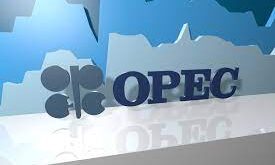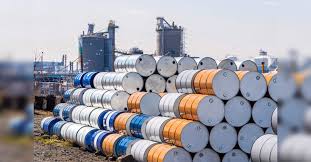The year 2019 was fraught with events for global oil markets. However. as far as the pricing was concerned the impacts were weak and short-lived on the market. That could have largely affected the oil market in the middle of the decade. but by the end of the last decade of the 21st century. the impact has been meager. In other words. 2019 ended the same way it had started. No significant development was witnessed in the trend of prices with which are mainly concerned producers. consumers. speculators and market analysts. Nonetheless. in the final hours of 2019. oil prices experienced an unpredicted jump to cross $70 a barrel. an unprecedented record since 2018.
Oil Demand
We start surveying the oil market survey with the demand side. The US-China trade war is not new. however. rarely could one believe some unbelievable decisions would take effect.
China holds the second largest hard currency reserves. just behind the United States. The issue of modifying the US-China trade balance dates from the Bill Clinton era in the 1990s. The Federal Reserve always worried that China relying on its huge hard currency reserves. would cause the US an irreparable financial crisis. China with its $1.27 trillion reserves could significantly affect the US dollar’s valuation. in which case. its own economy would have been affected by losing the world’s largest economy.
US President Donald Trump started his baleful views in 2018. and subsequently in 2019 he levied new tariffs on the US’s imports of 150 Chinese items. That negatively affected China’s economic growth. Trump aimed to strike a trade balance between the two nations and reform the yuan-dollar conversion rates so as to render US exports to China economical.
It is not popular for a pro-OPEC oil analyst to start analyzing the market focusing on demand side. We have long been analyzing the oil market based on supply side figures. This may be a message that the supply-dominated era is faced with challenges.
During the whole first decade and most of the second decade of the 21st century. China’s economy was the driving force behind the oil consumption and demand growth in the world. It continues to be such. but with a downward trend and in light of worrying signs about its extent. In fact. economic developments in China are a determining factor for economic growth in South Korea. Singapore. Thailand. the Philippines and even China and the European Union. China’s downward and somewhat uncertain growth is extensive and the US wants to curtail it. Trump believes that Europe and Asia owe their development to the US economy and now other nations are required to take action to help the US economy have a jump.
Therefore. on the eve of the end of the second decade of the present century. the global oil market is mainly concerned with volatile demand. In fact. the uncertain future of demand is a problem beyond low demand because reductions are periodical. Such ambiguity in reduced oil demand involves the US economy. too. Imposing new tariffs on imports from China inflicts costs on US consumers. That poses a threat to American consumers’ purchasing power as Americans are earning less revenue for gasoline and energy spendings. In the long-term. it would be more economical for the US to produce goods which it currently imports from China. But this process is long-term and may take at least a decade.
Supply Challenges
On the supply side. the issue of shale oil and gas was not taken seriously up until the middle of the second decade of the 21st century. Within five years. shale oil production changed the US’s status from a net importer of crude oil to a net exporter. Shortly. 7 mb d of oil was added to the market regular supply. Although it was costly. it required high-tech and harmed the environment.
Meantime. the US increased its conventional crude oil production by 1.3 mb d in late October 2019. Regardless of opposition to oil exploitation in the protected Alaska zone. Trump also authorized oil exploration without Congress approval in the zones that had not been authorized to produce oil even in the midst of the 1973-1975 oil crisis.
Under such circumstances. the Organization of the Petroleum Exporting Countries (OPEC) was led to reveal some of its untold secrets. OPEC’s core comprises five founding partners and six co-partners. Throughout its 60-year-old history. never has OPEC been able to supply regularly more than 33.4 mb d of oil. In fact. the bulk of OPEC’s production capacity was created when international oil companies were operating in the member states. Since early 1970s. when OPEC members were encouraged by Libya’s leader Moamer Gaddafi to expel international oil companies (IOCs) and replace them with national oil companies (NOCs). investments were made mainly to make up for the natural depletion of wells and therefore no capacity enhancement was done. That is while NOCs frequently release reports about new oil find. The new explorations never led to significant capacity building in any OPEC member state. Meanwhile. non-OPEC producers have been regularly building new capacity. The non-OPEC capacity building has mainly come from Russia and Central Asian republics and Caucasus.
OPEC+ Deal
Under such abnormal and worrying circumstances caused by ambiguous and weakened supply and OPEC’s weakened status. Russia agreed after two decades to cooperate with OPEC. It is noteworthy that cooperation between OPEC and non-OPEC producers was first brought up by Iran. During an OPEC Conference. Iran formally submitted the proposal for Azerbaijan’s OPEC membership. which Saudi Arabia vetoed.
The Declaration of Cooperation signed in September 2018 between OPEC and non-OPEC started with a 1.2 mb d cut from output. The OPEC+ deal became more significant in December 2019 after OPEC and non-OPEC partners agreed to further cut their combined oil output.
As Qatar and Ecuador have pulled out of OPEC. figures changed slightly. however. the OPEC+ deal delivered a positive message to the market. which was desperately felt since early last year. The 177th meeting of the OPEC Conference convinced the market that conventional crude oil producers were firmly determined to help stabilize the market in favor of both producers and consumers. At the December 5-6 meeting of OPEC and OPEC+. delegates from shale oil producing companies were also in attendance to follow up on the negotiations. Shale oil is currently produced for $40 a barrel. but due to low margins. there is little willingness for investment. Shale oil producers are mainly small and medium-sized companies whose resilience to oil price fluctuations is limited. Therefore. they want to be assured about market conditions. Shale oil has yet to test the waters in international markets. Shale oil is super-light crude oil with an API gravity of 50. Even in North America. few refineries can easily treat shale oil.
Aramco and 177th Meeting
The ordinary meeting of the OPEC Conference was overshadowed by Saudi Aramco’s long-awaited initial public offering (IPO). The issue of privatization and internationalization of Aramco. as the world’s largest oil company. was first raised in mid-2015 and turned out to be very controversial. Global oil prices definitely affect Aramco stocks’ valuation. Saudi Arabia made serious efforts several months ago to upgrade the global market and boost the value of Aramco’s shares. There was speculation about invitation to Russian oil companies to buy shares in Aramco. Russia was also trying to gain concessions by tying Aramco’s IPO with the OPEC+ deal.
Just 72 hours before finalizing Aramco’s IPO. Saudi Arabia said it was listing on domestic stock exchanges. That kept Russia out of the loop.
Saudi Arabia’s decision to privatize a small portion of Aramco’s shares was an audacious act that was tied with the OPEC meeting. The Saudi government initially planned to list Aramco on international stock markets. but due to global oil conditions and attacks on its facilities. only 1.5% of Aramco shares were traded domestically.
Oil Geopolitics
Geopolitical developments have always affected global markets. The September attacks on Saudi oil facilities in Abqaiq suddenly removed 6 mb d from Saudi oil production. However. oil prices jumped only 3.2% in the market.
Aramco has more than 110 million barrels of oil reserves ready for delivery. Therefore. the company managed to fulfill its obligations vis-à-vis buyers. But for one week following the attacks. nobody knew when Aramco would be able to repair its damaged facilities.
That sent a significant message to producers and the markets. It would be vital to give assurances to markets about sufficient oil supply. Under normal conditions. some events are likely to largely change prices. When supply is certain. the oil market is less affected. In fact. geopolitical risks caused by supply and demand have found a new form and the structures are playing a decisive role. Oil speculators have been marginalized by IT companies.
Environment: From Reality to Imagination
The year 2019 may be described as the year of environmentalists. Opponents of fossil fuels did not hesitate to lay the blame on fossil fuels for environmental damage throughout 2019. It has to be acknowledged that OPEC and oil and gas producers acted passively. OPEC and OPEC+ found themselves under tacit apology conditions. Maybe in the future. as technology grows solar panels become cleaner. Then. fossil fuels can also become clean by incorporating modern technologies.
Renewable energy advocates and lobbies have come to the scene with their plans. Therefore. the OPEC Secretariat is required to display its readiness. which would not be limited to public relations and publicity. Oil has to envisage new demand and functions. The petroleum industry cannot and should not wait for the success or failure of car manufacturers and consumers’ view of electrified cars.
Oil Market in 2020
The current year will be fraught with challenges for the oil market. 2020 will present fear and hope to oil producers. OPEC is faced with limited options.
Will Russia continue to stick with its OPEC+ commitments? To what extent will Russia continue to honor the Declaration of Cooperation?
Russia is incessantly seeking to expand its markets and win bigger shares. Russia’s view of oil market is largely affected by its gas market perspective. In other words. Russia regards oil exports and markets as its strategic target. Therefore. restraint in oil production is strategically costly for Moscow. Russia expects Saudi Arabia to bear such costs in return for its commitment to the OPEC+ deal. Russia expects Saudi Arabia and OPEC to play the role of a swing producer in favor of Russia. Russia expects OPEC to make efforts to preserve its market share.
Saudi Arabia’s reaction to possible non-conformity by Russia and other non-OPEC oil producers would be a major cause of concern for OPEC in 2020.
Will Saudi Arabia. Russia and others submit to an all-out price war? If any producer crosses the red lines set by others. the mid-1980s years are likely to recur.
If a price war breaks out. what would happen to shale oil then? Daniel Yergin says shale oil production below $40 a barrel will be cut by half within six months. impossible to be back to previous levels.
The future of Aramco’s listing. which Saudi leaders have tied to their future. will be the main bargaining chip wielded by Saudi Arabia’s rivals during the next OPEC+ meeting.
 Iran Energy News Oil, Gas, Petrochemical and Energy Field Specialized Channel
Iran Energy News Oil, Gas, Petrochemical and Energy Field Specialized Channel



